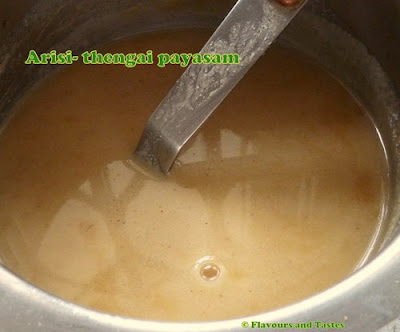.JPG)
I had wanted to learn making khandvis for a long time. Though I have recipe in cookbooks and have known how they look from a favourite eatery's menu, I was apprehensive trying them on my own. I discussed this with a friend here. She has lived in Mumbai a long time and has friends from various states of India, having worked in a bank until few years ago. She suggested we meet for lunch one day and she will demonstrate the making of Khandvi. So last Thursday was convenient for both of us and we fixed a day out for ourselves.
I was amazed at the ease with which she cooked it, giving me tips along side. The best part of it was we did not have many dishes to clean up after the cooking. A bowl in which she mixed the batter, the pan in which she cooked and two plates on which she spread the cooked batter and a ladle!!! That was interesting for me.
She told me that she had learnt it from a friend, whose mother would make paper-thin layers. The lady would add lot of water and cook for long stirring constantly. The end result will be very desirable. However, her friend had told her that even with lesser water added to the batter and cooking on a low flame is good enough; not to waste time and fuel, a small compromise wouldn't matter. Yet I did not find the sheets thick, rolled well and looked appealing as delicious as they tasted.
Here is the recipe she used to make about 18 pieces. Her tips, I have added as while preparing.
Ingredients:
1/3 cup (heaped) gram flour
1/3 cup slightly sour curd (some recipes suggest more, but my friend used only equal quantity to the gram flour) (beaten)
1 cup water
Salt as per taste
1teaspoon sugar (optional)
2 teaspoons ginger - green chilli paste
2 teaspoons ginger - green chilli paste
1/4 teaspoon turmeric powder
1/4 teaspoon asafoetida
3 tablespoons cooking oil
For tempering and garnishing:
2 teaspoons cooking oil
1 teaspoon mustard seeds
2 teaspoons sesame seeds
2 tablespoons grated coconut
2 tablespoons chopped fresh corriander leaves
Mix the gramflour, salt, ginger-chilli paste, beaten curds and water. Obtain a smooth thin batter which is free of lumps. Add the sugar, asafoetida and turmeric powders also.
Heat oil in the pan and add the prepared batter.
Stirring continuosly, cook the batter until well cooked. The indication is that the batter will obtain a light brown tinge, glaze from the oil and will not stick to the walls of the pan.
The batter should still be in a semi liquid state, tipping more towards solid state. Over cooking it will result in a mass that will not spread.
Keep a big flat dish over-turned ready, having generously greased the surface.
Transfer the cooked batter quickly on this surface and with the ladle spread it in a thin sheet over the surface. This has to be done very fast as the batter will thicken as it cools and become difficult to spread. also you will find that it coagulates in tiny masses.
Allow this to cool just about manageably warm. Too much cooling will thicken the mass and render it become unable to roll.
Using a knife make strips of this sheet. Roll each strip into spirals. Place them in a separate dish.
If the batter has been cooked evenly and correctly, the strips will easily roll and not crack in the middle.
Put the pan on the stove and heat the oil for tempering. Add the mustard and sesame seeds. When they crackle spread them over the rolled khandvis. Garnish with a generous sprinkling of fresh, grated coconut and chopped corriander leaves.
Put the pan on the stove and heat the oil for tempering. Add the mustard and sesame seeds. When they crackle spread them over the rolled khandvis. Garnish with a generous sprinkling of fresh, grated coconut and chopped corriander leaves.
Serve them as starters or snacks. Avoid handling them too much prior to serving. They have to be handled delicately while serving, but devouring on them is altogether a different issue!
I would love to try on my own soon. She has warned me that it is not easy tp perfect this dish within one or two trials. There is also a recipe making it in the microwave in one cookbook I have.
I shall update my trial experiment at some future date, hopefully. I am determined to try because both my husband and I liked them very much.
I shall update my trial experiment at some future date, hopefully. I am determined to try because both my husband and I liked them very much.






.JPG)


.JPG)






.JPG)

.JPG)



.JPG)





.JPG)


.JPG)

.JPG)
.JPG)
.JPG)
.JPG)


